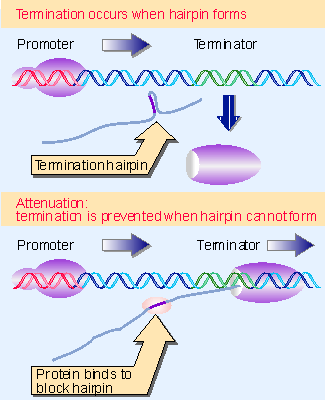12. Alternative secondary structures control attenuation
10.12 Alternative secondary structures control attenuation |
| Key terms defined in this section |
| Attenuation describes the regulation of termination of transcription that is involved in controlling the expression of some bacterial operons. Attenuator is the terminator sequence at which attenuation occurs. |
RNA structure provides an opportunity for regulation in both prokaryotes and eukaryotes. Its most common role occurs when an RNA molecule can take up alternative secondary structures by utilizing different schemes for intramolecular base pairing. The properties of the alternative conformations may be different. This type of mechanism can be used to regulate the termination of transcription, when the alternative structures differ in whether they permit termination. Another means of controlling conformation (and thereby function) is provided by the cleavage of an RNA; by removing one segment of an RNA, the conformation of the rest may be altered. It is possible also for a (small) RNA molecule to control the activity of a target RNA by base pairing with it; the role of the small RNA is directly analogous to that of a regulator protein. We might regard the ability of an RNA to shift between different conformations with regulatory consequences as comprising the nucleic acid’s alternative to the allosteric changes of conformation that regulate protein function. Both these mechanisms allow an interaction at one site in the molecule to affect the structure of another site.
Several operons are regulated by attenuation, a mechanism that controls the ability of RNA polymerase to read through an attenuator, which is an intrinsic terminator located at the beginning of a transcription unit. The principle of attenuation is that some external event controls the formation of the hairpin needed for intrinsic termination. If the hairpin is allowed to form, termination prevents RNA polymerase from transcribing the structural genes. If the hairpin is prevented from forming, RNA polymerase elongates through the terminator, and the genes are expressed. Different types of mechanisms are used in different systems for controlling the structure of the RNA.
 |
Figure 10.39 Attenuation occurs when a terminator hairpin in RNA is prevented from forming. |
Attenuation may be regulated by proteins that bind to RNA, either to stabilize or to destabilize formation of the hairpin required for termination. Figure 10.39 shows an example in which a protein prevents formation of the terminator hairpin. The activity of such a protein may be intrinsic or may respond to a small molecule in the same manner as a repressor protein responds to corepressor.
In B. subtilis, a protein called TRAP (formerly called MtrB) is activated by tryptophan to bind to a sequence in the leader of the nascent transcript (Otridge and Gollnick, 1993; Babitzke et al., 1993) (for review see Gollnick, 1994). TRAP forms a multimer of 11 subunits. Each subunit binds a single tryptophan amino acid and a trinucleotide (GAG or UAG) of RNA. The RNA is wound in a circle around the protein (Antson et al., 1999). The result is to maintain in single-stranded form the adjacent regions that are required to form the terminator hairpin, thus repressing production of the tryptophan biosynthetic enzymes. In effect, TRAP is a terminator protein that responds to the level of tryptophan. In the absence of TRAP, an alternative secondary structure precludes the formation of the terminator hairpin.
The bgl operon is controlled by the ability of the protein BglG to bind to a sequence in the 5′ nontranslated leader of the transcript. Binding of BglG sequesters part of the sequence required for formation of an intrinsic terminator hairpin. BglG therefore acts as an antiterminator.
| Reviews | |
| Gollnick, P. (1994). Regulation of the B. subtilis trp operon by an RNA-binding protein.. Mol. Microbiol. 11, 991-997. | |
| Research | |
| Antson, A. A. et al. (1999). Structure of the | |
| Babitzke, P. and Yanoksy, C. (1993). Reconstitution of B. subtilis trp attenuation in vitro with TRAP, the trp RNA-binding attenuation protein.. Proc. Nat. Acad. Sci. USA 90, 133-137. | |
| Otridge, J. and Gollnick, P. (1993). MtrB from B. subtilis binds specifically to trp leader RNA in a tryptophan-dependent manner.. Proc. Nat. Acad. Sci. USA 90, 128-132. | |